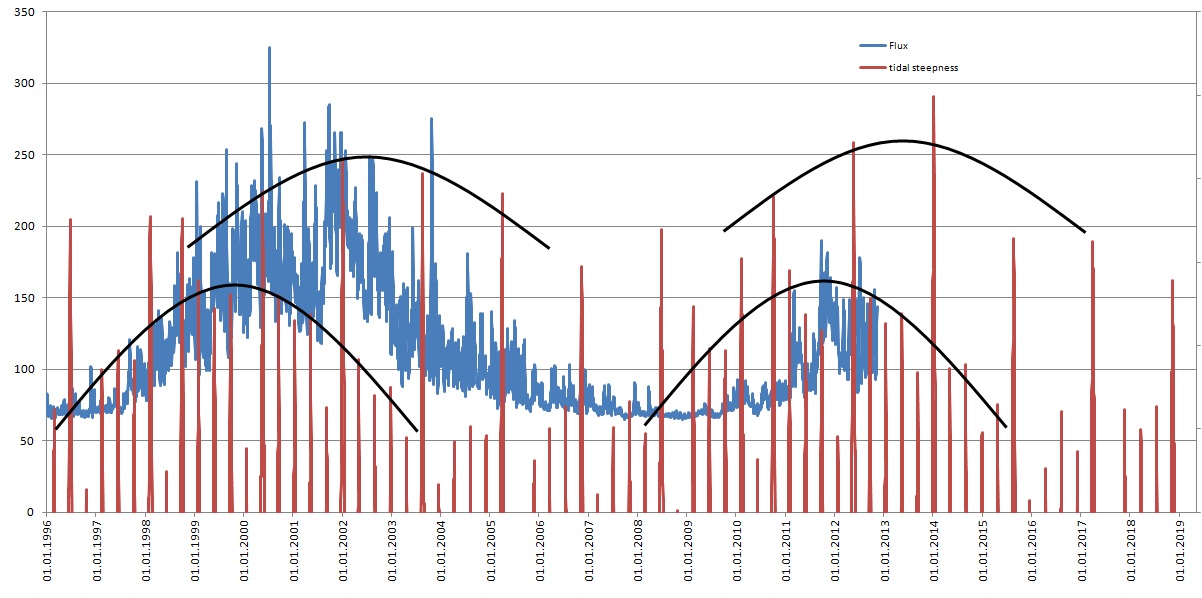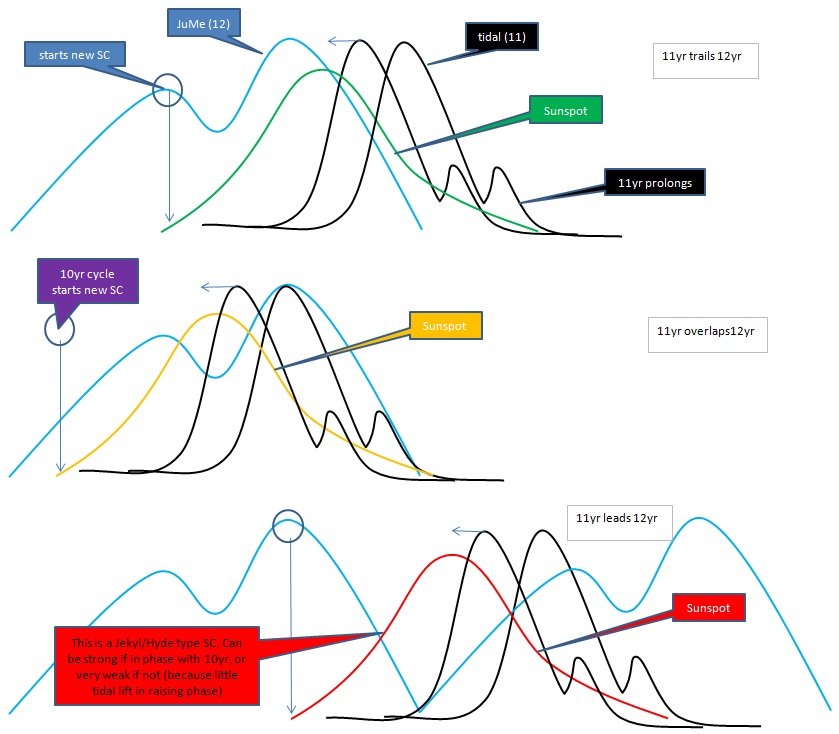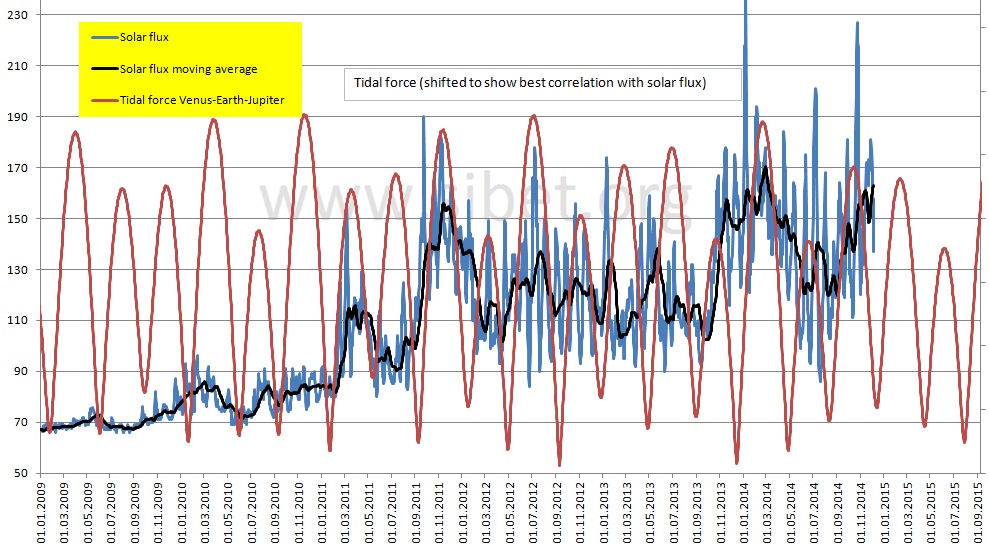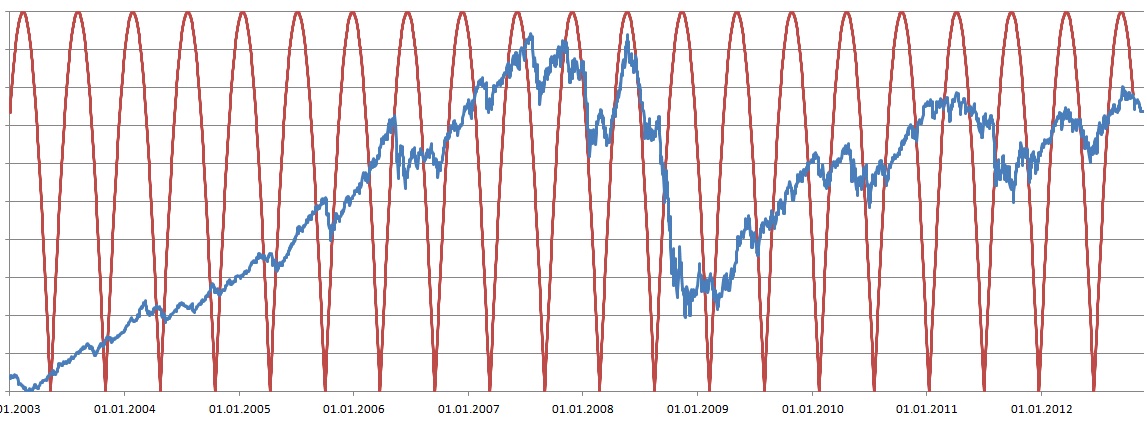bigbud
Level 3 Rank
  
Posts: 180
|
Post by bigbud on Nov 15, 2012 22:11:59 GMT
have I found something? The 12 year Jupiter cycle is much about tidal forces. When Jupiter is closer to the Sun (perihelion), the tidal forces are stronger. But the 11-year cycle of Venus+Earth+Jupiter syzygies has been troubling me. That one is also about tidal forces, but my calculations has so far not been able to identify this as a significant cycle in tidal forces. Been playing with some models, and dont know if the physics is right here... but here is a model of tidal waves, and the steepness of the waves. And suddenly the 11year cycle emerges... Here I show the height of the tidal wave (blue) and the steepnes in orange. Ideal would be to get a "total strengt" number, but have to work on that. Attachments:
|
|
bigbud
Level 3 Rank
  
Posts: 180
|
Post by bigbud on Nov 15, 2012 23:12:47 GMT
here is "tidal steepness" versus solar flux For SC23 and 24 i have shown the maximums of the two tidal cycles of 12 and 11 years Maybe this graph is all I need? The higher the wave is, the steeper it is. And the tighter the planets are alligned, the steeper it gets...  |
|
bigbud
Level 3 Rank
  
Posts: 180
|
Post by bigbud on Nov 21, 2012 12:16:42 GMT
"tidal steepness" does likely not exist, and there is no 11-year VeEaJu-cycle.
The only cycle affecting tides is the 11,86-year Jupiter cycle. There are some slight variations from Mercury and Venus+Earth, but they are secondary.
The main cycle is allthough still ~11 years, and probably some property of the sun itself. This still needs some explaination.
But the most interesting cycle is the 10-year Jupiter-Saturn cycle, that is probably related to solar wobble. This cycle explains "everything" regarding SC-strength. It also is related to timing, where the two other cycles also are involved.
The 10 year JuSa-cycle also suggests an explaination to the grand minima, and is something like this:
If you slow down your car, you have to accelerate from a low gear. otherwise the car stalls with a high gear.
At the Gleissberg lows of Dalton and 1900 the Sun shifted to a low gear, and accelerated out of the low. But in ~1645 the Sun tried to accelerate with a high gear, and therefore stalled. And needed several decades to start up again.
The interesting aspect is why this happende, which is related to timing and why the cycles made this setup.
Another thing that I find, is that the strong solar cycles with SSN>120 seem to be too high. This suggests a non-linear relationship, or that strong cycles amplify themselves.
|
|
bigbud
Level 3 Rank
  
Posts: 180
|
Post by bigbud on Nov 21, 2012 21:57:41 GMT
next challenge is to examin the 11-year cycle - is it simply some kind of internal solar dynamo-cycle?
Why is it 11 years? Is it a result of the 9,93 and 11,86 year cycles?
Playing with some numbers is an intitial phase:
Fibonacci levels, or the golden ratio, suggest 11,12 years could be an interesting number
And with 11,1392 we get perfect beats with the 9,93 and 11,86 year cycles
My average for solar cycles -12 to 24 is 11,12 years
So if it is the dynamo... is it a ridgid cycle, or does it change (stretch, switch, slide)?
|
|
bigbud
Level 3 Rank
  
Posts: 180
|
Post by bigbud on Nov 22, 2012 10:58:55 GMT
trying to remove the 11yr Venus-Earth-Jupiter cycle from the "equation" shows that it cannot be done. So it is a significant cycle in the tidal-part of the deal.
But is it the driver behind the 11yr dynamo oscillation? Dont think so, but it may contribute to it.
Anyway... I am seeing what is going on right now, and is it not given what kind of outcome we get.
As I work with stocmarkets, I see an anology:
When markets are overbought you want to see selling, cash building up on the sideline, an oversold condition and a new rally.
Dangerous is when the overbought condition extends. People dont take profit, but lend more money to put into the market. That may end with a crash, but doesnt have to.
Right now we have a similar condition on the Sun. It also looks like the anology with the decelerating/accelerating car. You need a low gear to accelerate from a low velocity, or the car will stall from a high gear.
The sun is "overbought" and decelerating. It tries to remain in a high gear, which is dangerous. Looks like the next solar cycle 25 will be the decider. The sun may stall (grand minimum) or it can get "lucky" and avoid the stall.
But right now it looks to me that it is gonna stall...
edit: SC25 should not be in any grand minimum, but the SC26 could potentially if it starts very late. A late SC25-max will be a hint.
|
|
bigbud
Level 3 Rank
  
Posts: 180
|
Post by bigbud on Nov 23, 2012 14:21:08 GMT
it is always two steps forward and one back, but seems like I am very close now  Venus+Earth+Jupiter syzygies is important in the equation, and part of the tidal picture. So the tidal part is the combination of the 12 year cycle (double top because of Mercury) and the 11 year cycle. The other part is the 10 year cycle. When the 11/12-year cycles are overlapping, they dominate. And when the 11/12 year cyles are even distributed, the 10 year cycle dominates. So in spite of being the weakest cycle, the 11 year cycle plays an so important role that it can be mistaken to be the strongest one. There is still one unresolved thing, and it is whether there is a dynamo oscillation (memory) that affects the picture... (btw did stockmarkets bottom near Nov 20?) |
|
|
|
Post by sigurdur on Nov 23, 2012 16:26:48 GMT
Looks like a short term bottom (ref stock market).
Commodities are up today as sales were good last week.
Congress/President look like they might plug the leak for a few months.
Never know.....but hopefully sanity is returning.
|
|
bigbud
Level 3 Rank
  
Posts: 180
|
Post by bigbud on Nov 25, 2012 14:53:30 GMT
it is all really simple  There are 7 classes of sunspot cycles They are made up of the combination of the 10 year JuSa-cycle and the 12-year Jupiter cycle. The 12-year cycle has two tops because of Mercury (separated by ~4 years), and a drifting variation because of the 11-year cycle. There are 3 main classes depending on the overall 12/11-year situation. Group 1: starts at Ju-top 2. Can be normal (in phase with JuSa), double (contains two JuSa-cycles and becomes a long cycle), and the last is out of phase with JuSa Group 2: starts at Ju-top 1. Can be normal (in phase with JuSa), double (contains two JuSa-cycles and becomes a long cycle), and the last is out of phase with JuSa Group 3: starts between Ju-top 1 and 2 (in the long ~8 year interval) and is (must be) in phase with JuSa A Gleissberg low occurs when a sunspotcycle contains two JuSa-cycles, like SC4, SC11 and SC23. In this way one JuSa cycle is "lost", making the following sunspot cycles being out of phase with JuSa. This slows down sunspot activity. A catastrophe occurs if two JuSa cycles are "lost" in a few decades, which slows down sunspot activity too much. This happened at SC-12 and SC-10 that both were "double cycles" To make a grand minimum the SC25 must be a double cycle, and SC26 not begin before summer 2034. Then SC26 will start a grand minimum. Right now that doesnt seem likely, but a closer examination of the tidal cycles (Venus+Earth+Jupiter) must be done... |
|
bigbud
Level 3 Rank
  
Posts: 180
|
Post by bigbud on Nov 27, 2012 16:44:25 GMT
this is the tidal cyclical configuration of themain three sunspotsycle-groups It is all about timing. A new sunspotcycle is triggered by a "kick" from either the 12-year cycle (green and red type) or (per definition) by the 10 year cycle (yellow) So it is interesting that two different cycles can start a new SC but the 11-year cycle cant The initial "kick" must come in the right time. If it comes too early, it will prolong the previous SC. So the previous SC must first die. Also we see that once a SC is triggered, it doesnt need strong cyclical influence to grow (but that will be a weak cycle).  |
|
bigbud
Level 3 Rank
  
Posts: 180
|
Post by bigbud on Dec 17, 2012 9:19:27 GMT
tidal cycle is forecasting a low in sunspot here, and should start to rise again in some weeks time  |
|
|
|
Post by karlox on Dec 17, 2012 12:34:37 GMT
For a layman, Bigbud please...
What I can "read" here in the chart above is that tidal-combined forces have some effect -depending on the part of the cycle we are looking at- as for variations in SN... but it really doesn´t look as something very linear or strong? Am I missing something?
Thanks in advance!
|
|
bigbud
Level 3 Rank
  
Posts: 180
|
Post by bigbud on Dec 17, 2012 13:06:36 GMT
Hi karlox If you look at the tidal variation versus flux (the black moving average) you should see some correlation. Sometimes the correlation is not that good. This is a simplyfied version, excluding the effect of Mercury. Also this is just a part of the picture, because there are bigger cycles that regulate the overall sunspot cycle. But the tidal cycle produces local tops and lows in solar flux Large tidal peaks should have a more noticeable effect than weak tides. Attachments:
|
|
|
|
Post by karlox on Dec 17, 2012 19:00:27 GMT
I can see now more correlation as the cycle progresses til today... Is that right?
|
|
|
|
Post by france on Jan 5, 2013 22:29:32 GMT
here is "tidal steepness" versus solar flux For SC23 and 24 i have shown the maximums of the two tidal cycles of 12 and 11 years Maybe this graph is all I need? The higher the wave is, the steeper it is. And the tighter the planets are alligned, the steeper it gets...  so with this graph maximum could produce between april and december 2013 |
|
bigbud
Level 3 Rank
  
Posts: 180
|
Post by bigbud on Mar 12, 2013 22:42:25 GMT
I suggest that you two, particularly the marketeer, read Nassim Nicholas Taleb, both his professional and popular writings. Of course you recognize the retired quant. Here's his personal website www.fooledbyrandomness.com/some see randomness, other see patterns...  Stockmarket cycle (which is a solar cycle) has another top now like last fall, and next low around June Update on solar flux and ~4month planetary tidal cycle: Tidal cycle indicated top around late February, and low in flux around late April. Looks like the top came a bit early, and the correlation is never perfect  This is with Mercury added in the equation  |
|